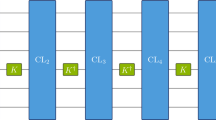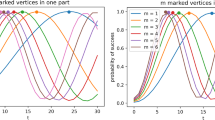Abstract
Unitary k-designs are probabilistic ensembles of unitary matrices whose first k statistical moments match that of the full unitary group endowed with the Haar measure. In prior work, we showed that the automorphism group of classical \({\mathbb {Z}}_4\)-linear Kerdock codes maps to a unitary 2-design, which established a new classical-quantum connection via graph states. In this paper, we construct a Markov process that mixes this Kerdock 2-design with symplectic transvections, and show that this process produces an \(\epsilon \)-approximate unitary 3-design. We construct a graph whose vertices are Pauli matrices, and two vertices are connected by directed edges if and only if they commute. A unitary ensemble that is transitive on vertices, edges, and non-edges of this Pauli graph is an exact 3-design, and the stationary distribution of our process possesses this property. With respect to the symmetries of Kerdock codes, the Pauli graph has two types of edges; the Kerdock 2-design mixes edges of the same type, and the transvections mix the types. More precisely, on m qubits, the process samples \(O(\log (N^5/\epsilon ))\) random transvections, where \(N = 2^m\), followed by a random Kerdock 2-design element and a random Pauli matrix. Hence, the simplicity of the protocol might make it attractive for several applications. From a hardware perspective, 2-qubit transvections exactly map to the Mølmer–Sørensen gates that form the native 2-qubit operations for trapped-ion quantum computers. Thus, it might be possible to extend our work to construct an approximate 3-design that only involves such 2-qubit transvections.
Similar content being viewed by others
References
Brandão F.G., Horodecki M.: Exponential quantum speed-ups are generic. Quantum Inf. Comput. 13(11–12), 901–924 (2013) [Online]. Available: https://arxiv.org/abs/1010.3654.
Calderbank R., Rains E., Shor P., Sloane N.: Quantum error correction via codes over GF(4). IEEE Trans. Inf. Theory 44(4), 1369–1387, (1998) [Online]. Available: https://arxiv.org/abs/quant-ph/9608006.
Cameron P.J., Van Lint J.H.: Designs, Graphs, Codes and their Links, vol. 3. Cambridge University Press, Cambridge (1991).
Can T., Rengaswamy N., Calderbank R., Pfister H.D.: Kerdock codes determine unitary 2-designs. IEEE Trans. Inf. Theory 66(10), 6104–6120 (2020) [Online]. Available: http://arxiv.org/abs/1904.07842.
Chau H.F.: Unconditionally secure key distribution in higher dimensions by depolarization. IEEE Trans. Inf. Theory 51(4), 1451–1468 (2005).
Cleve R., Leung D., Liu L., Wang C.: Near-linear constructions of exact unitary 2-designs. Quantum Inf. Comput. 16(9–10), 0721–0756 (2016) [Online]. Available: https://arxiv.org/pdf/1501.04592.pdf.
Dankert C., Cleve R., Emerson J., Livine E.: Exact and approximate unitary 2-designs and their application to fidelity estimation. Phys. Rev. A 80(1), 012304 (2009) [Online]. Available: https://link.aps.org/doi/10.1103/PhysRevA.80.012304.
DiVincenzo D., Leung D., Terhal B.: Quantum data hiding. IEEE Trans. Inf. Theory 48(3), 580–598 (2002).
Emerson J., Alicki R.,Życzkowski K.: Scalable noise estimation with random unitary operators. J. Opt. B Quantum Semiclassical Opt. 7(10), S347–S352 (2005) [Online]. Available: https://doi.org/10.1088/1464-4266/7/10/021.
Gottesman D.: An introduction to quantum error correction and fault-tolerant quantum computation. arXiv preprint (2009) [Online]. Available: http://arxiv.org/abs/0904.2557.
Hammons A.R., Kumar P.V., Calderbank A.R., Sloane N.J.A., Solé P.: The \(\mathbb{Z}_4\)-linearity of Kerdock, Preparata, Goethals, and related codes. IEEE Trans. Inf. Theory 40(2), 301–319 (1994).
Harrow A.W., Low R.A.: Random quantum circuits are approximate 2-designs. Commun. Math. Phys. 291(1), 257–302 (2009).
Hayden P., Horodecki M., Winter A., Yard J.: A decoupling approach to the quantum capacity. Open Syst. Inf. Dynam. 15(1), 7–19 (2008) [Online]. Available: http://arxiv.org/abs/quant-ph/0702005.
Koenig R., Smolin J.A.: How to efficiently select an arbitrary Clifford group element. J. Math. Phys. 55(12), 122202 (2014).
Kueng R., Zhu H., Gross D.: Distinguishing quantum states using Clifford orbits. arXiv preprint (2016) [Online]. Available: http://arxiv.org/abs/1609.08595.
Kueng R., Zhu H., Gross D.: Low rank matrix recovery from Clifford orbits (2016). arXiv preprint. http://arxiv.org/abs/1610.08070.
Linke N.M., Maslov D., Roetteler M., Debnath S., Figgatt C., Landsman K.A., Wright K., Monroe C.: Experimental comparison of two quantum computing architectures. Proc. Natl. Acad. Sci. 114(13), 3305–3310 (2017) [Online]. Available: https://www.pnas.org/content/114/13/3305/.
Magesan E., Gambetta J.M., Emerson J.: Characterizing quantum gates via randomized benchmarking. Phys. Rev. A 85(4), 042311 (2012) [Online]. Available: https://link.aps.org/doi/10.1103/PhysRevA.85.042311.
McEliece R.J.: Finite Fields for Computer Scientists and Engineers. Kluwer Academic Publishers, Dordrecht (1987).
Nakata Y., Hirche C., Morgan C., Winter A.: Unitary 2-designs from random X- and Z-diagonal unitaries. J. Math. Phys. 58(5), 052203 (2017) [Online]. Available: http://aip.scitation.org/doi/10.1063/1.4983266.
Nielsen M.A., Chuang I.L.: Quantum Computation and Quantum Information. Cambridge University Press, Cambridge (2010).
Rengaswamy N.: Classical coding approaches to quantum applications. Ph.D. dissertation, Duke University (2020) [Online] Available: http://arxiv.org/abs/2004.06834.
Rengaswamy N., Calderbank R., Kadhe S., Pfister H.D.: Synthesis of logical Clifford operators via symplectic geometry. In: Proc. IEEE Int. Symp. Inf. Theory, June, pp. 791–795 (2018) [Online]. Available: http://arxiv.org/abs/1803.06987v1.
Rengaswamy N., Calderbank R., Kadhe S., Pfister H.D.: Logical Clifford synthesis for stabilizer codes. IEEE Trans. Quantum Eng. 1 (2020) [Online]. Available: http://arxiv.org/abs/1907.00310.
Roy A., Scott A.J.: Unitary designs and codes. Des. Codes Cryptogr. 53(1), 13–31 (2009) [Online]. Available: http://link.springer.com/10.1007/s10623-009-9290-2.
Salam A., Al-Aidarous E., Farouk A.E.: Optimal symplectic householder transformations for SR decomposition. Linear Algebra Appl. 429, 1334–1353 (2008).
Singal T., Hsieh M.-H.: A possible improvement to the convergence analysis of the transvection Markov process. personal communication (2021).
Szehr O., Dupuis F., Tomamichel M., Renner R.: Decoupling with unitary approximate two-designs. New J. Phys. 15(5), 053022 (2013) [Online]. Available: https://doi.org/10.1088/1367-2630/15/5/053022.
Webb Z.: The Clifford group forms a unitary 3-design. Quantum Inf. Comput. 16(15–16), 1379–1400 (2016) [Online]. Available: https://arxiv.org/pdf/1510.02769.pdf.
Wilde M.M.: Quantum Information Theory, 2nd edn Cambridge University Press, Cambridge (2017).
Zhu H.: Multiqubit clifford groups are unitary 3-designs. Phys. Rev. A 96, 062336 (2017) [Online]. Available: https://link.aps.org/doi/10.1103/PhysRevA.96.062336.
Acknowledgements
We are grateful to Tanmay Singal and Min-Hsiu Hsieh for pointing out that we needed to define the Pauli graph as a directed graph in order to accurately analyze the Transvection Markov Chain. They also communicated that it is possible to improve the convergence analysis to \(O(\log (N^3/\epsilon ))\) [27]. The work of N. Rengaswamy and R. Calderbank was supported in part by the National Science Foundation (NSF) under Grant No. 1908730.
Author information
Authors and Affiliations
Corresponding authors
Additional information
Publisher's Note
Springer Nature remains neutral with regard to jurisdictional claims in published maps and institutional affiliations.
This is one of several papers published in Designs, Codes and Cryptography comprising the “Special Issue: The Art of Combinatorics—A Volume in Honour of Aart Blokhuis”.
Rights and permissions
About this article
Cite this article
Tan, X., Rengaswamy, N. & Calderbank, R. Approximate unitary 3-designs from transvection Markov chains. Des. Codes Cryptogr. 90, 2181–2204 (2022). https://doi.org/10.1007/s10623-021-01000-4
Received:
Revised:
Accepted:
Published:
Issue Date:
DOI: https://doi.org/10.1007/s10623-021-01000-4




